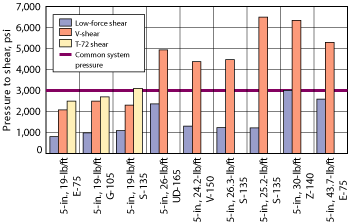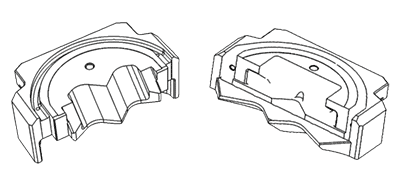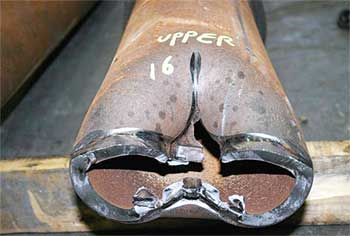Low-force shear rams In this issue you’ll see articles on several new and innovative drilling technologies. Some of them are so sweet they just make me want to drool. One that is not included, however, involves a new concept in blind/shear ram technology that is both elegant and simple—NOV’s new puncture shear ram. This is possibly the best new technology in blowout preventer design that I have seen in my 40-odd years in the oilpatch. Engineers began working on this new design several years ago. Like most new ideas, it took time to germinate, and it was shelved for a time while engineers were assigned to other, more important tasks. The new design has now been perfected and patented, and it was presented to the public during the IADC International Well Control Middle East Conference and Exhibition, December 2–3, 2008, in Muscat, Oman. I was able to get a private showing of the presentation and a chance to chat with the design engineers.
The design goal was to shear 5½-in., 26.3-lb/ft and 6⅝-in., 25.2-lb/ft S-135 drillpipe using a reduced BOP operating pressure of 2,500 psi with a 15¼-in. operating cylinder in a conventional ram BOP. If successful, this would preclude the use of boosters to provide the force necessary to cut this high-strength pipe and seal on the open hole. Their first attempts were to modify existing V-notch rams by changing the blade angles (the “V” shape) and the face height. This involved over 40 block designs and more than 500 shear tests, which resulted in a 30% reduction in shearing force. While this was clearly an improvement, the engineers weren’t completely satisfied. So they looked at new types of shear ram concepts, over 22 of them. What came out of this analysis represents a true step change in blind/shear ram design. The principle upon which this design is based is simple—cutting through just one pipe wall at a time with each blade. The method is equally simple—a “nose” on each ram face first punctures the pipe and the remainder of the blade shears through the wall as each ram advances, Fig. 1.
Conventional T-72 shear rams flatten the pipe, fold it over, and cut both wall thicknesses at one time. V-shears also mash the top of the fish remaining in the hole, complicating fishing. Pumping down the fish is all but impossible using either type. The new puncture shear ram blocks distort the top of the fish, but leave it much less damaged than previous designs. Two experienced drilling foremen who saw the presentation immediately noted that an overshot could catch the top of the fish without first dressing it with a mill. Also, the pipe remains open so fluid can be pumped down the fish, Fig. 2. Amazing!
Most importantly, the force required to sever either the 5½-in. or 6⅝-in. drillpipe is only a fraction of that of conventional blind/shear rams. For S-135 pipe, only 1,150 psi is required compared to 2,620 psi using a V-notch blind/shear ram. Similar results were found for other grades, e.g., E-75 (860 vs. 2,210 psi) and G-105 (1,070 vs. 2,810 psi), see graph. Clearly, the new shear design is able to cut just about any common drillpipe diameter and grade without boosters in conventional BOP stacks at operating pressures of 3,000 psi or less. Talk about great—it could only get better if the top of the fish was not mashed at all, but then we’re talking about a completely different kind of cutting mechanism. Now you can see why I’m so excited about this new technology. In a recent meeting where this new concept was being discussed, one 35-year veteran made an interesting observation. He said, “This is such a good idea, I wonder why nobody thought of it sooner?” That’s the way innovation works. Ideas are formed slowly and concepts mature in parallel with needs. That’s what’s so great about innovation.
|
||||||||||||||||
- Coiled tubing drilling’s role in the energy transition (March 2024)
- Using data to create new completion efficiencies (February 2024)
- Digital tool kit enhances real-time decision-making to improve drilling efficiency and performance (February 2024)
- E&P outside the U.S. maintains a disciplined pace (February 2024)
- U.S. operators reduce activity as crude prices plunge (February 2024)
- Drilling advances (January 2024)







